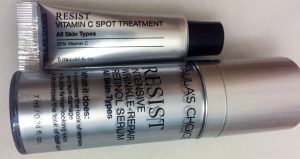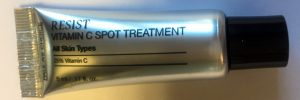As our skin matures we have to up the game with regard to our skincare regime. Serums are perhaps the most important part of the process and we need to ensure we chose a product packed with the most beneficial ingredients, by which I mean vitamins. You will have seen serums containing Vitamin A (retinols), Vitamin C and Vitamin E and are perhaps a little confused about what they actually do, so here’s my guide to help you chose the best product for you.
Vitamin A – Retinols – “the skincare miracle”:
Retinols have been used in skin care for around 50 years since Dermatologists noticed that Retin-A, an acne treatment, also improved the appearance of wrinkles and skin tone. They act directly on the DNA and help to speed up the many cell functions that slow once we hit 30. They increase cell production so the skin gets rid of damaged cells more quickly and the top layer of skin looks healthier, retinols actually thin the top layer and make the second layer thicker (the epidermis) which makes the skin more luminous and firm. There is also evidence that retinols boost the production of collagen, aid the body’s process of cell hydration, improve the appearance of sun damage, lines, acne, scars and dark spots.
For new users it’s best to start with a milder product as retinols can cause some sensitivity, increased redness, drying and flaking when first used but this usually wears off after a short time. Retinol is an antioxidant and not an exfoliant, the flaking reaction is not exfoliation it could mean that the retinol is too strong for your skin and you should change to a less potent formulation. If it doesn’t wear off then I would discontinue use. How much retinol should you look for in a product when you are a newbie? Mild concentrations of 0.01% have produced good results in tests and are an ideal starting point, you can then progress to a slightly higher level of up to 0.1% and ultimately if you feel you need more help you could look for products containing 0.5 to 1% and upwards to 2%. It’s better to start low and let your skin get used to it, you can always get a stronger product next time, rather than going for 2% straight away and putting yourself off retinols for good because it’s too much for your skin. Packaging is also important, vitamin A is prone to breaking down so look for an airtight packaging such as a pump.

The most important thing to remember when using retinol is to apply a high SPF sunscreen (over 30), the new cells which will be exposed will obviously be much more susceptible to sunburn. The old recommendation was to only use retinol on a night but new research says that you can use a retinol on a morning as long as you don’t forget the sunscreen.
So where to incorporate the serum into your routine? Cleanse your face as usual, cleansers with alpha or beta hydroxy acids are ok but avoid granular cleansers, wait a few minutes if necessary, to avoid stinging and then smooth onto your face, including around the eyes as well as neck, decolletage and hands, use your other serums as well you don’t have to limit yourself to one. Finish with your usual moisturiser. If your skin is extra sensitive you can put the moisturiser on first. Use twice weekly for 2 weeks and then increase to three times a week. Some users incorporate retinols into their routine every day and only you can decide if your skin is ok with this, I stick to 3 times a week. It can take up to 12 weeks to notice a significant improvement, but lots of people notice a change in a much shorter time. Retinol works fabulously with vitamin C as vitamin C stabilises it, however, if using vitamins A and C together causes sensitivity then use them at different times of the day or on alternate days. Which brings me nicely onto my next recommendation…
Vitamin C:
When you think of vitamin C you probably think of that ingredient to help fight off colds and flu, but as it’s a powerful antioxidant it’s great as a part of your skincare routine it protects against free radical damage from the environment which can breakdown your collagen and lead to more wrinkles and sagging. It’s also great for evening out skin tone, skin hydration and it has anti-inflammatory properties. This all seems really logical when you think back to history lessons (and old films) about scurvy being caused by a lack of vitamin C. There are various different types of vitamin C, L-ascorbic acid is probably the most researched with regard to skincare as it boosts collagen, smoothes and firms the skin, but all types of vitamin C will give you some benefit. As with the vitamin A (retinol) look for products in airtight containers as antioxidants break down when exposed to light, air and water, so look for a product that’s not water based.

It was always recommended that you use your vitamin C on a morning in order to help protect your skin from environmental damage, however, new products can be quite potent and should be used at night so make sure you read the instructions. You can use vitamin C at any age, the earlier the better from 18 up, but obviously with the collagen building properties it’s a must as part of an “anti-ageing” skincare routine. I’ve just treated myself to some Paula’s Choice products which I am excited to try, NIOD also produce a great product – Ethylated L-ascorbic acid 30% Network. I look for products with high levels of vitamin C 20 to 30% but as with the vitamin A, if you’ve never used it before look for a lower percentage to start with (eg No 7 Youthful Vitamin C) in case of skin irritation. Always use a high factor sunscreen, which we all should be doing anyway.
Vitamin E (Tocopherol):
Those pesky free radicals which are flying around waiting to have adverse effects on our skin can be fought off with Vitamin E, thereby reducing wrinkles and keeping the skin young looking. Vitamin E also is an antioxidant, excellent moisturiser and a powerful anti-inflammatory, as I discussed in my Turmeric post, inflammation is a major factor in skin ageing. Vitamin E can also reduce sun damage by minimising the damaging reactions in the skin, even though it is NOT a sunscreen. It also prevents the degeneration of DNA and therefore aids against premature ageing. Vitamin E oil helps to repair age spots by lubricating the cell membranes and encouraging cell regeneration. It can also be used on cuticles and lips to prevent dryness and chapping. As with vitamins A and C watch out for skin reactions .
It’s very thick and greasy so probably best used on a night instead of a moisturiser if you want to use it in it’s unadulterated form. There are lots of products containing Vitamin E but antioxidants work best in blends, so look for something containing vitamin C or CoEnzyme Q10 as well. Look out for “Tocopherol” on the labels as this is the form of Vitamin E which works best on human skin, in fact it makes up the majority of our skin’s natural antioxidant defense system so any top up can only be a good thing.
I hope this post has proved to be helpful and clarify why we should be using these vitamins in our serums/creams. Our skincare regimes are turning into a bit of a science lesson these days but I do think we are becoming a lot more aware and knowledgeable about what’s available out there.